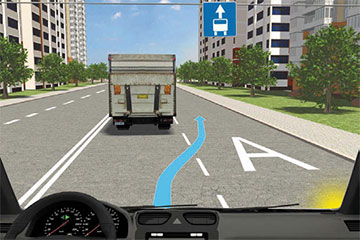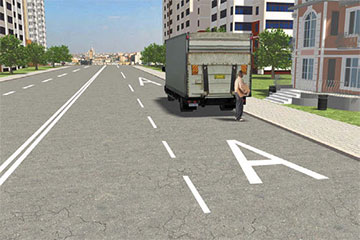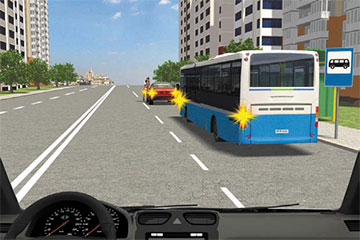Therefore, according to Norayr Bludyan, it would be advisable to consider the placement of special posts at some public transport stops. At the same time, absolutely all stopping points should not be fenced off with posts, fences and walls, the Moscow city news agency reported Bludyan.
Should I give way to small buses (minibuses) leaving the bus stop?
so if you don't mind the side of your car, you can follow the rules.Everyone should give in to each other. But since everyone asks themselves the same stupid questions, no one ever gives in to anyone. Hence the fucking on the roads. Tell me that it is not so.
According to the traffic rules, he is obliged, but in practice, if the driver is daring, he will go himself, and you will slow down, and the brake pedal is on the floor (((((Especially in traffic jams, he sticks his muzzle into your lane and you will let him fall in love) ))
Depends on the status of the minibus.
Preschooler. RF
To increase responsibility for children's compliance with the rules road traffic, the formation of sustainable knowledge and strong skills of cultural behavior on the street, in transport in preschool institutions, special classes and thematic events are held. Learning should be started from an early age, using all available forms and methods. Children should be not just passive listeners, but actively participate in the development of new knowledge.
What is the penalty for a stop
Based on this, in paragraph 12.4 of the SDA it is written that it is forbidden to stop at stops. It is also forbidden to stop in the stopping area, which extends over 15 meters.
It is very easy to determine the place of stopping by the presence of road signs - "trolleybus, tram, bus stop." It is also prohibited to stop at taxi stops. In addition to road signs, the stop point is highlighted with special markings applied to the roadbed.
Synopsis of the traffic rules lesson on the topic: "Urban public transport"
You can ride the bus both sitting and standing. For seated passengers, rows of seats are located near the windows. For those who are standing, there are crossbars - handrails so that you can hold onto them and not fall while driving. Buses that travel to other cities or abroad may have a TV, toilet and other additional amenities. You can often see the so-called "double bus" or "accordion bus" on the roads.
Is the bus obliged to give way to cars if it leaves the bus stop?
2) the beginning of movement is carried out from a place that does not have a stop designation (there is no pointer to which road sign 5.16 "Place of the bus and (or) trolleybus");
Also, the bus driver is obliged to give way to approaching emergency services vehicles with flashing beacons and a special sound signal on.
Traffic rules public transport stop
or sending the car to a special parking lot.The traffic rules clearly regulate in what cases will not entail any punishment: forced stop, boarding and disembarking of passengers. Also, the driver has the right to stop at a stop if he does not interfere with the movement of route vehicles. The stop zone for fixed-route vehicles extends to 15 meters before and after the stop, it must be marked with the appropriate sign: stop for tram, route taxi, bus, stop on demand.
SDA Section 12. Stopping and parking according to the Rules of the road
Trucks with a permissible maximum weight of over 3.5 tonnes on the left side of one-way roads, only stopping for loading or unloading is permitted.It is allowed to park the vehicle in one row parallel to the edge of the carriageway. Two-wheeled vehicles without a side trailer may be parked in two rows.
The way a vehicle is parked or parked is determined by sign 6.
Forum of Chelyabinsk Motorists
Bogomazov to court. According to the car enthusiast, he was cut off by the route Gazel, turning from the middle lane, although, according to the sign, it could only go straight.The respondent in this case was the traffic police. As the head of the department of legal regulation and international cooperation of the traffic police of the Russian Federation, Yuri Shakirov, explained to the publication, such exceptions are necessary for the normal operation of public transport in large cities.
Traffic rules sections: 1. General provisions 2. General duties of drivers 3. Use of special signals 4. Duties of pedestrians 5. Duties of passengers 6. Signals of traffic lights and traffic controller 7. Use of emergency signaling and emergency stop signs 8. Starting traffic, maneuvering 9. Location vehicle on the carriageway 10. Speed \u200b\u200bof movement 11. Overtaking, advancing, oncoming passing 12. Stops and parking 13. Crossroads 14. Pedestrian crossings and stopping places of route vehicles 15. Traffic through railway tracks 16. Traffic on motorways 17. Traffic in residential zones 18. Priority of route vehicles 19. Use of external lighting devices and sound signals 20. Towing power-driven vehicles 21. Training driving 22. Transportation of people 23. Transportation of goods 24. Additional requirements for the movement of cyclists and moped drivers 25. Additional requirements for the movement of horse-drawn carts, as well as for driving animals
18. Priority of route vehicles
Traffic rules point: 18.1 18.2 18.3
18.1. Outside intersections, where tram lines cross the carriageway, the tram has priority over trackless vehicles, except when leaving the depot.
18.2. On roads with a lane for route vehicles, marked with signs 5.11.1, 5.13.1, 5.13.2, 5.14, the movement and stopping of other vehicles (except for school buses and vehicles used as passenger taxis, as well as cyclists - if the lane for route vehicles is located on the right) on this lane.
If this lane is separated from the rest of the carriageway by a broken line marking, then when turning, vehicles must rebuild on it. It is also allowed in such places to drive into this lane when entering the road and for embarking and disembarking passengers at the right edge of the carriageway, provided that this does not interfere with route vehicles.
18.3. In settlements, drivers must give way to trolleybuses and buses starting from the designated stopping point. Trolleybus and bus drivers can only start moving after they are sure that they are given way.
Comments (1)
|
alex
11/23/2017 at 09:59 a large-capacity bus - a delivery service that transports passengers along a specific route, numbered and marked with appropriate signs, can move along the public transport lane? [Reply] [Cancel reply] |
18.2. On roads with a lane for route vehicles marked signs 5.11, 5.13.1, 5.13.2, 5.14 , the movement and stopping of other vehicles (with the exception of vehicles used as a passenger taxi) on this lane is prohibited.
 You are prohibited from moving or stopping on the lane intended for route vehicles (the lane is indicated by a marking in the form of the letter A, as well as the sign "Lane for route vehicles") |
 The truck driver also violated the Rules by stopping at the lane with such markings to unload (load) the cargo |
If this lane is separated from the rest of the carriageway by a dashed marking line, then when turning, vehicles must rebuild on it. It is also allowed in such places to drive into this lane when entering the road and for embarking and disembarking passengers at the right edge of the carriageway, provided that this does not interfere with route vehicles.
18.3. In settlements, drivers must give way to trolleybuses and buses starting from the designated stopping point. Trolleybus and bus drivers can only start moving after they are sure that they are given way.
 |
In front of you is a designated stop located at locality... You must give way to the starting bus, even if it changes to the second lane |

